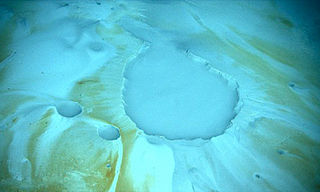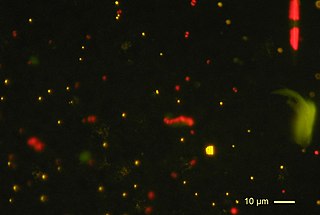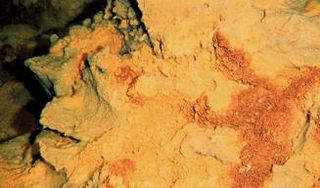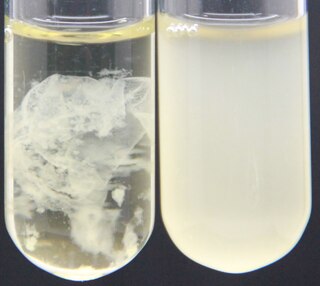Related Research Articles
A halophile is an extremophile that thrives in high salt concentrations. In chemical terms, halophile refers to a Lewis acidic species that has some ability to extract halides from other chemical species.

A biofilm is a syntrophic community of microorganisms in which cells stick to each other and often also to a surface. These adherent cells become embedded within a slimy extracellular matrix that is composed of extracellular polymeric substances (EPSs). The cells within the biofilm produce the EPS components, which are typically a polymeric combination of extracellular polysaccharides, proteins, lipids and DNA. Because they have a three-dimensional structure and represent a community lifestyle for microorganisms, they have been metaphorically described as "cities for microbes".
Anaerobic respiration is respiration using electron acceptors other than molecular oxygen (O2). Although oxygen is not the final electron acceptor, the process still uses a respiratory electron transport chain.
A chaotropic agent is a molecule in water solution that can disrupt the hydrogen bonding network between water molecules. This has an effect on the stability of the native state of other molecules in the solution, mainly macromolecules by weakening the hydrophobic effect. For example, a chaotropic agent reduces the amount of order in the structure of a protein formed by water molecules, both in the bulk and the hydration shells around hydrophobic amino acids, and may cause its denaturation.

Haloarchaea are a class of prokaryotic organisms under the archaeal phylum Euryarchaeota, found in water saturated or nearly saturated with salt. Halobacteria are now recognized as archaea rather than bacteria and are one of the largest groups. The name 'halobacteria' was assigned to this group of organisms before the existence of the domain Archaea was realized, and while valid according to taxonomic rules, should be updated. Halophilic archaea are generally referred to as haloarchaea to distinguish them from halophilic bacteria.
In biology, syntrophy, syntrophism, or cross-feeding is the cooperative interaction between at least two microbial species to degrade a single substrate. This type of biological interaction typically involves the transfer of one or more metabolic intermediates between two or more metabolically diverse microbial species living in close proximity to each other. Thus, syntrophy can be considered an obligatory interdependency and a mutualistic metabolism between different microbial species, wherein the growth of one partner depends on the nutrients, growth factors, or substrates provided by the other(s).

A brine pool, sometimes called an underwater lake, deepwater or brine lake, is a volume of brine collected in a seafloor depression. The pools are dense bodies of water that have a salinity that is three to eight times greater than the surrounding ocean. Brine pools are commonly found below polar sea ice and in the deep ocean. Those below sea ice form through a process called brine rejection. For deep-sea brine pools, salt is necessary to increase the salinity gradient. The salt can come from one of two processes: the dissolution of large salt deposits through salt tectonics or geothermally heated brine issued from tectonic spreading centers.

Gammaproteobacteria is a class of bacteria in the phylum Pseudomonadota. It contains about 250 genera, which makes it the most genus-rich taxon of the Prokaryotes. Several medically, ecologically, and scientifically important groups of bacteria belong to this class. All members of this class are Gram-negative. It is the most phylogenetically and physiologically diverse class of the Pseudomonadota.

The Global Ocean Sampling Expedition (GOS) is an ocean exploration genome project whose goal is to assess genetic diversity in marine microbial communities and to understand their role in nature's fundamental processes. It was begun as a Sargasso Sea pilot sampling project in August 2003; Craig Venter announced the full expedition on 4 March 2004. The two-year journey, which used Craig Venter's personal yacht, originated in Halifax, Canada, circumnavigated the globe and terminated in the U.S. in January 2006. The expedition sampled water from Halifax, Nova Scotia to the Eastern Tropical Pacific Ocean. During 2007, sampling continued along the west coast of North America.

Picoeukaryotes are picoplanktonic eukaryotic organisms 3.0 µm or less in size. They are distributed throughout the world's marine and freshwater ecosystems and constitute a significant contribution to autotrophic communities. Though the SI prefix pico- might imply an organism smaller than atomic size, the term was likely used to avoid confusion with existing size classifications of plankton.
The Xanthobacteraceae are a family of bacteria that includes Azorhizobium, a genus of rhizobia. Xanthobacteraceae bacteria are diverse and Gram-negative, rod-shaped, and may be motile or non-motile depending on the specific bacteria. Their cells range in size from 0.4–1.0 × 0.8–6 µm, but when grown in the presence of alcohol as the sole carbon source, they can reach up to 10 µm in length. These bacteria do not form spores and have opaque, slimy colonies that appear slightly yellow due to the presence of zeaxanthin dirhamnoside.

Bacterial phyla constitute the major lineages of the domain Bacteria. While the exact definition of a bacterial phylum is debated, a popular definition is that a bacterial phylum is a monophyletic lineage of bacteria whose 16S rRNA genes share a pairwise sequence identity of ~75% or less with those of the members of other bacterial phyla.

The class Zetaproteobacteria is the sixth and most recently described class of the Pseudomonadota. Zetaproteobacteria can also refer to the group of organisms assigned to this class. The Zetaproteobacteria were originally represented by a single described species, Mariprofundus ferrooxydans, which is an iron-oxidizing neutrophilic chemolithoautotroph originally isolated from Kamaʻehuakanaloa Seamount in 1996 (post-eruption). Molecular cloning techniques focusing on the small subunit ribosomal RNA gene have also been used to identify a more diverse majority of the Zetaproteobacteria that have as yet been unculturable.

The root microbiome is the dynamic community of microorganisms associated with plant roots. Because they are rich in a variety of carbon compounds, plant roots provide unique environments for a diverse assemblage of soil microorganisms, including bacteria, fungi, and archaea. The microbial communities inside the root and in the rhizosphere are distinct from each other, and from the microbial communities of bulk soil, although there is some overlap in species composition.
Persephonella guaymasensis is a thermophilic, hydrogen-oxidizing microaerophile first isolated from a deep-sea hydrothermal vent. It is strictly chemolithoautotrophic, microaerophilic, motile, 2-4 micrometres in size, rod-shaped, Gram-negative and non-sporulating. Its type strain is EX-H2T.
Xeromyces is a monotypic genus of fungus in the family Monascaceae. Its only species, Xeromyces bisporus, was first described by L.R. Fraser in 1954. No subspecies are listed in the Catalogue of Life.

A floc is a type of microbial aggregate that may be contrasted with biofilms and granules, or else considered a specialized type of biofilm. Flocs appear as cloudy suspensions of cells floating in water, rather than attached to and growing on a surface like most biofilms. The floc typically is held together by a matrix of extracellular polymeric substance (EPS), which may contain variable amounts of polysaccharide, protein, and other biopolymers. The formation and the properties of flocs may affect the performance of industrial water treatment bioreactors such as activated sludge systems where the flocs form a sludge blanket.

All animals on Earth form associations with microorganisms, including protists, bacteria, archaea, fungi, and viruses. In the ocean, animal–microbial relationships were historically explored in single host–symbiont systems. However, new explorations into the diversity of marine microorganisms associating with diverse marine animal hosts is moving the field into studies that address interactions between the animal host and a more multi-member microbiome. The potential for microbiomes to influence the health, physiology, behavior, and ecology of marine animals could alter current understandings of how marine animals adapt to change, and especially the growing climate-related and anthropogenic-induced changes already impacting the ocean environment.
Fermentibacteria is a bacterial phylum with candidate status. It is part of the FCB group.

NC10 is a bacterial phylum with candidate status, meaning its members remain uncultured to date. The difficulty in producing lab cultures may be linked to low growth rates and other limiting growth factors.
References
- 1 2 Hamaguchi & Geiduschek (1962). "The Effect of Electrolytes on the Stability of the Deoxyribonucleate Helix". J. Am. Chem. Soc. 84 (8): 1329–1338. doi:10.1021/ja00867a001.
- 1 2 Hallsworth, J.E. (1998). "Ethanol-induced water stress in yeast". Journal of Fermentation and Bioengineering. 85 (2): 125–137. doi:10.1016/S0922-338X(97)86756-6.
- 1 2 Hallsworth, J.E., Heim, S. and Timmis, K. (2003). "Chaotropic solutes cause water stress in Pseudomonas putida". Environmental Microbiology. 5 (12): 1270–1280. doi:10.1111/j.1462-2920.2003.00478.x. PMID 14641573.
{{cite journal}}: CS1 maint: multiple names: authors list (link) - 1 2 Bhaganna, P.; et al. (2010). "Hydrophobic substances induce water stress in microbial cells". Microbial Biotechnology. 3 (6): 701–716. doi:10.1111/j.1751-7915.2010.00203.x. PMC 3815343 . PMID 21255365.
- ↑ Ball, P.; Hallsworth, J.E. (2015). "Water structure and chaotropicity: their uses, abuses and biological implications". Physical Chemistry Chemical Physics. 17 (13): 8297–8305. Bibcode:2015PCCP...17.8297B. doi:10.1039/C4CP04564E. PMID 25628033.
- ↑ Cray, J.A.; et al. (2013). "A universal measure of chaotropicity and kosmotropicity". Environmental Microbiology. 15 (1): 287–296. doi:10.1111/1462-2920.12018. PMID 23145833.
- ↑ Hallsworth, J.E.; et al. (2007). "Limits of life in MgCl2-containing environments: chaotropicity defines the window". Environmental Microbiology. 9 (3): 801–813. doi:10.1111/j.1462-2920.2006.01212.x. PMID 17298378.
- ↑ Alves, F.L.; et al. (2015). "Concomitant osmotic and chaotropicity-induced stresses in Aspergillus wentii: compatible solutes determine the biotic window". Current Genetics. 61 (3): 457–477. doi:10.1007/s00294-015-0496-8. PMID 26055444. S2CID 14826577.
- ↑ Cray, J.A.; et al. (2015). "Chaotropicity: a key factor in product tolerance of biofuel-producing microorganisms". Current Opinion in Biotechnology. 33: 228–259. doi:10.1016/j.copbio.2015.02.010. PMID 25841213.